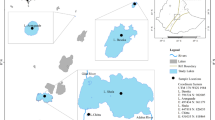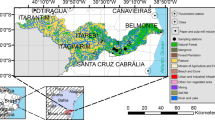Abstract
This study, carried out between November 2003 and February 2005, aimed to investigate the temporal trends of conductivity, ions, nutrient concentrations and phytoplankton biomass expressed as chlorophyll a in the Kenyan Rift Valley saline-alkaline lakes namely Nakuru, Bogoria and Elmentaita. The influence of environmental variables on phytoplankton biomass has always been of much interest in understanding phytoplankton dynamics. Being shallow and endorheic, these lakes’ chemical, physical and biological properties were found to be strongly influenced by the hydrologic cycle within their catchment area. The lakes are characterised by high nutrient concentrations but with low Ntot : Ptot ratios. Significant differences between surface and near-bottom samples for water temperature, chlorophyll a and some nutrients were found in these lakes. A stepwise Discriminant Analysis with lakes as defined groups resulted in a significant model with SRP, nitrate–N, conductivity and light supply being of major importance. A significant correlation between specific conductivity and total alkalinity (Kendalls τ = 0.85, n = 132) was calculated. While L. Bogoria showed the least temporal variation in conductivity – (65–73 mS cm−1), larger variations were observed in L. Elmentaita (21–77 mS cm−1). Na+ and K+ form the main cations with Cl−, HCO −3 and CO 2−3 being the major anions in all the three lakes. Flouride was detected in high quantities (mean values L. Bogoria 72 meq l−1, L. Nakuru 17 meq l−1 and L. Elmentaita 71 meq l−1). A PCA followed by multiple regression analysis with chlorophyll a as dependent variable showed that nitrate-N, conductivity, phosphorus and light supply were the key variables influencing algal biomass in these lakes.





Similar content being viewed by others
References
APHA, 1995. Standard methods for the Examination of Water and Wastewater, 19th edn. American Public Health Association, Washington, DC, USA.
Ballot, A., 2004. Cyanobacteria in Kenyan Rift Valley lakes. A Ph.D Dissertaion submitted to the Freie Universitat–Berlin, Germany, 146 pp. http://www.diss.fu-berlin.de/2004/116/.
Ballot, A., L. Krienitz, K. Kotut, C. Wiegand, J. S. Metcalf, G. A. Codd & S. Pflugmacher, 2004. Cyanobacteria and cyanobacterial toxins in three alkaline Rift Valley lakes of Kenya-Lakes Bogoria, Nakuru and Elmentaita. Journal Plankton Research 26: 925–935.
Burgis, M. J. & P. Morris, 1987. The Natural History of Lakes. Cambridge University Press, Cambridge, 218.
Ganf, G. G. & P. Blazka, 1974. Oxygen uptake, ammonia and phosphate excretion by zooplankton of a shallow equatorial lake (Lake George, Uganda). Limnology and Oceanography 19: 313–325.
Grant, W. D., W. E. Mwatha & B. E. Jones, 1990. Alkaliphiles: ecology, diversity and applications. FEMS Microbiology Reviews 75: 255–270.
Harper, D. M., R. B. Childress, M. M. Harper, R. R. Boar, P. Hickey, S. C. Mills, N. Otieno, T. Drane, E. Vareschi, O. Nasirwa, W. E. Mwatha, J. P. E. C. Darlington & X. Escute-Gasulla, 2003. Aquatic biodiversity and saline lakes: Lake Bogoria National Reserve, Kenya. Hydrobiologia 500: 259–276.
James, M. R., 1987. Seasonal changes in metabolic rates of zooplankton and their importance to phytoplankton production in two New Zealand lakes of contrasting trophic state. New Zealand Journal of Marine and Freshwater Research 21: 573–583.
Jones, B. E. & W. D. Grant, 1999. Microbial diversity and ecology of the Soda Lakes of East Africa. In Bell, C. R., Brylinsky M. & J. P. Johnson-Green (eds), Microbial Biosystems: New Frontiers: Proceedings of the 8th International Symposium for Microbial Ecology (2000). Atlantic Canada Society for Microbial Ecology, Halifax, Canada, 681–687.
Kilham, P., 1981. Pelagic bacteria: extreme abundances in African saline lakes. Naturwissenschaften 68: 380–381.
Legler, C., 1988. Ausgewählte Methoden der Wasseruntersuchung. Band 1. Gustav Fischer Verlag Jena, 517 pp.
McCall, J. G. H., 1967. Geology of the Nakuru-Thomson’s Fall - Lake Hannington Area. Republic of Kenya; Ministry of Natural Resources: Geological Survey of Kenya. Report Number 78, 122 pp.
Melack, J. M., 1976. Temporal variability of phytoplankton in tropical lakes. Oecologia 44: 1–7.
Melack, J. M., 1981. Photosynthetic activity of phytopalnkton in tropical African soda lakes. Hydrobiologia 81: 71–85.
Melack, J. M., 1988. Primary producer dynamics associated with evaporative concentration in a shallow, equatorial soda lake (Lake Elmenteita, Kenya). Hydrobiologia 158: 1–14.
Milbrink, G., 1974. On the limnology of two alkaline lakes (Nakuru and Naivasha) in the Rift Valley System in Kenya. Interantionale Revue der gesamten Hydrobiologie 62: 1–17.
Mwaura, F. & T. R. Moore, 1991. Forest and woodland depletion in the Lake Elementeita Basin, Kenya. Geoforum 22: 17–26.
Owino, A. O., J. O. Oyugi, O. O. Nasirwa & L. A. Bennun, 2001. Patterns of variation in waterbird numbers on four Rift Valley lakes in Kenya, 1991–1999. Hydrobiologia 458: 45–53.
Peters, H. R. & S. MacIntyre, 1976. Orthophosphate turnover in East African Lakes. Oecologia. 25: 313–319.
Richardson, J. L. & A. E. Richardson, 1972. History of an african rift valley lake and its climatic implications. Ecological monographs 42: 499–534.
Rippey, B. & R. B. Wood, 1985. Trends in major ion composition of five Bishoftu crater lakes. Ethiopian Journal of Science 8: 9–28.
Schagerl, M. & S. O. Oduor, 2007. Phytoplankton communities relationships to environmental variables in three Kenyan Rift Valley saline-alkaline lakes. Submitted to Limnology and Oceanography.
Sondergaard, M., E. Jeppesen, P. Kristensen & O. Sortkjaer, 1990. Interactions between sediment and water in a shallow and hypertrophic lake: a study on phytoplankton collapses in Lake Sobygard, Denmark. Hydrobiologia 191: 139–148.
Talling, J. F & D. Driver, 1961. Some problems in the estimation of chlorophyll-a in phytoplankton. In Proceedings of the conference on primary productivity measurement, marine and freshwater, held at University of Hawaii, August 21–September 6, 1961.
Talling, J. F. & J. Lemoalle, 1998. Ecological dynamics of tropical inland waters. Cambridge University Press, 441 pp.
Talling, J. F., 2001. Environmental controls on the functioning of shallow tropical lakes. Hydrobiologia 458: 1–8.
Vareschi, E., 1987. Saline lake ecosystems. In Schulze, E. D & H. Zwölfer (eds). Potentials and Limitations of Ecosystem Analysis. Springer-Verlag Publishers, Berlin, 435 pp.
Vareschi, E., 1982. The ecology of Lake Nakuru (Kenya) III. Abiotic factors and primary production. Oecologia 55: 81–101 pp.
Vareschi, E., J. M. Melack & P. Kilham, 1981. Saline waters. In Symoens, J. J., M. J. Burgis & J. J. Gaudet (eds), The Ecology and Urilization of African Inland Waters. UNEP Reports and Proceeding Series No. 1, Nairobi, 93–102.
Von Damm, K. L. & J. M. Edmond, 1984. Reverse weathering in The closed basin lakes of the Ethiopian Rift. American Journal of Science 284: 835–862.
Wood, R. B. & J. F. Talling, 1988. Chemical and algal relationships in a salinity series of Ethiopian inland waters. Hydrobiologia 158: 29–67.
Yasindi, A. W., D. H. Lynn & W. D. Taylor, 2002. Ciliated protozoa in Lake Nakuru, a shallow alkaline-saline lake in Kenya: Seasonal variation, potential production and role in the food web. Archiv für Hydrobiologie 154: 311–325.
Acknowledgement
This study was funded by the Austrian government through the OEAD a wing of the Austrian Development Cooperation to whom we are most grateful. We acknowledge and appreciate the assistance given by Geoffrey Ongondo during the sampling exercise. We also thank Hubert Kraill of Limnology Department, Vienna University for the ion analyses and Christian Fesl for many valuable comments and his attendance for discussion.
Author information
Authors and Affiliations
Corresponding author
Rights and permissions
About this article
Cite this article
Oduor, S.O., Schagerl, M. Temporal trends of ion contents and nutrients in three Kenyan Rift Valley saline–alkaline lakes and their influence on phytoplankton biomass. Hydrobiologia 584, 59–68 (2007). https://doi.org/10.1007/s10750-007-0605-x
Issue Date:
DOI: https://doi.org/10.1007/s10750-007-0605-x




